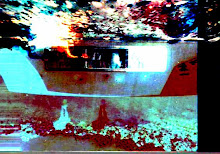Visæges is the final album from a trilogy of releases that I've been working on simultaneously since the end of last summer. I have mentioned this before in some of my last few posts but I'd like to describe the process again: sometime during last summer I started recording songs and eventually accumulated a formidable batch that I realized could be divided up by three distinct styles. I decided to create three different records from these songs, the first being the atmospheric EP, Dragonscales & Lambskin, comprised of mostly ambient pieces, the second was the mellow and largely acoustic guitar psych-folk LP Lily of the Valley, and finally Visæges. I had originally intended to release this album a few months ago, a little closer to the release of Lily, but I got sidetracked by Neon Panopticon. As a result, Visæges is perhaps the longest I've ever taken to work on an album with some breaks of a few weeks in between the overall process, which has been a couple months shy of a year.
I feel this long gestation period has yielded one of my strongest albums so far or at least one of my personal favorites, one that offers a substantial running time of just over 50 minutes but hopefully isn't too long and self-indulgent. By my standards, this record is sturdy and lean with ambient experimentation nearly non-existent. Instead, this is a heavily krautrock-indebted affair (of the Neu mold) with half of the songs powered by motorik beats and pumping basslines, with the other half largely being austere and industrial-tinged post-punk jams. The artwork was very much inspired by Joy Division's album art (and graphic designer Peter Saville's work in general) as well as Death in June's artwork style. Basically, this album was intended to be a rather dehumanized exploration of slowly building up songs through repetition and seeing how nuances emerge in that repetition before dismantling them.
DOWNLOAD:VISAEGES (LP)
